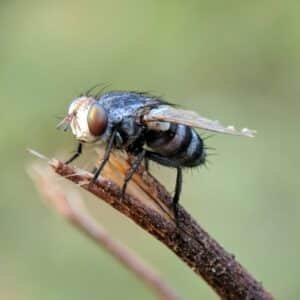
FLIES
FUN FACT
House flies can carry and transmit over 100 different pathogens, including bacteria, viruses, and parasites, making them significant vectors for diseases.
Schedule Your Fly RemovalCall (512) 764-5804Identification
Flies are common pests in Texas, with species such as house flies, fruit flies, and blow flies being particularly prevalent. These insects are known for their rapid reproduction and ability to thrive in various environments, including homes, farms, and food establishments. Flies are usually attracted to food sources, waste, and organic matter, where they lay their eggs.
Signs of Infestation
- Visible Flies: Seeing flies buzzing around, especially in kitchens, garbage areas, and near food.
- Larvae: Maggots, which are fly larvae, found in decaying organic matter or waste.
- Spotting: Small dark spots or streaks of fly feces on walls, ceilings, and other surfaces.
- Buzzing Sounds: The characteristic buzzing sound of flies can indicate their presence.
Breeding Season
Flies can breed year-round in Texas due to the warm climate. Female flies lay hundreds of eggs in organic matter, which hatch into larvae (maggots) within a day. The larvae then pupate and emerge as adult flies, completing their life cycle in about a week under optimal conditions.
Fun Fact
House flies can carry and transmit over 100 different pathogens, including bacteria, viruses, and parasites, making them significant vectors for diseases.
Ecosystem Role
While flies are often seen as pests, they play important roles in the ecosystem, including:
- Decomposition: Flies help break down and decompose organic matter, recycling nutrients back into the environment.
- Pollination: Some species of flies act as pollinators for various plants.
- Food Source: Flies serve as a food source for many animals, including birds, amphibians, and spiders.
Prevention Strategies
- Cleanliness: Keep your home clean, especially in kitchens and food storage areas. Regularly dispose of garbage and clean up spills.
- Seal Entry Points: Install screens on windows and doors, and seal cracks and gaps to prevent flies from entering your home.
- Proper Food Storage: Store food in airtight containers and promptly refrigerate perishables.
- Waste Management: Use tightly sealed garbage cans and regularly clean them to prevent attracting flies.
- Drain Maintenance: Clean drains regularly to remove organic buildup that can attract flies.
- Natural Repellents: Use natural repellents like basil, lavender, and mint, which can deter flies.
Prickly Pear’s Approach
- Inspection: Conduct a thorough inspection to identify fly species and infestation levels.
- Exclusion: Implement barriers such as screens and seal entry points to prevent flies from entering your home.
- Sanitation: Provide guidance on maintaining cleanliness and proper waste management to reduce attractants.
- Targeted Treatments: Use baits, traps, and insecticides to eliminate fly populations effectively.
- Ongoing Monitoring: Regularly monitor and adjust strategies to ensure long-term control.
Conclusion
Flies can quickly become a nuisance and a health hazard if not addressed promptly. Prickly Pear offers professional services to manage fly infestations and protect your home. If you suspect a fly problem, contact us for expert assistance in maintaining a clean and fly-free environment.
